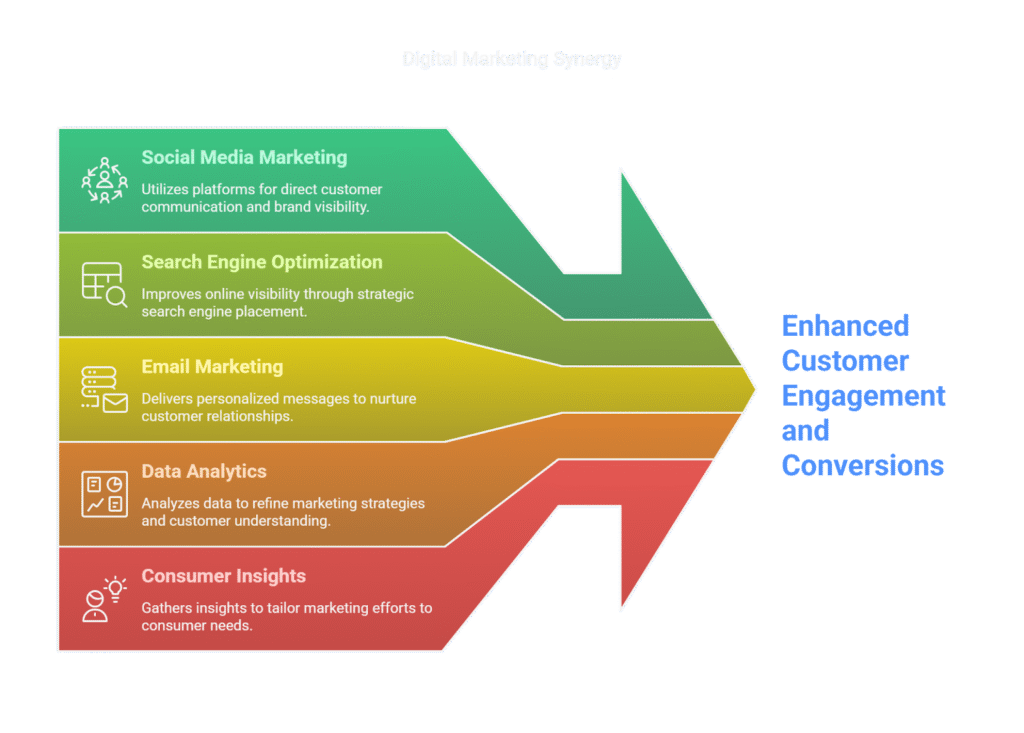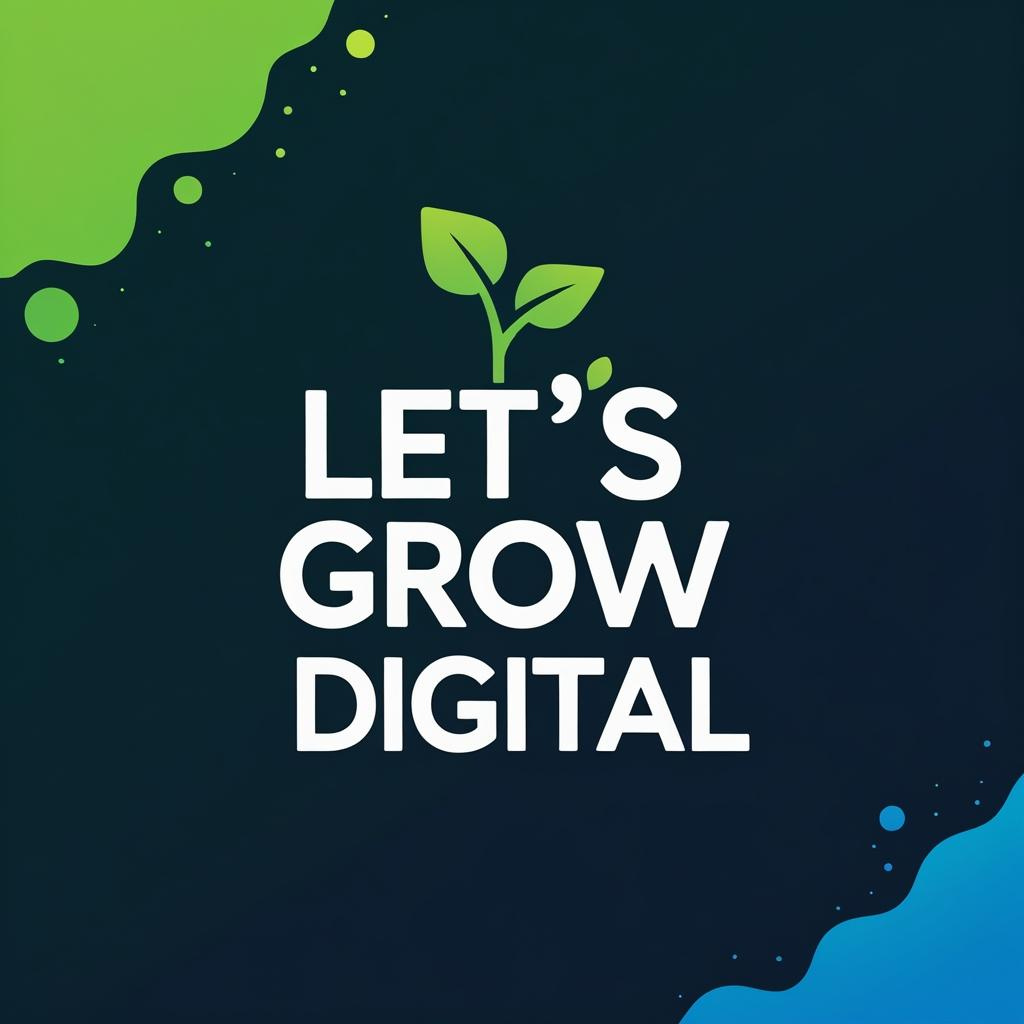At its core discussion about What is Digital Marketing? Types and examples- digital marketing is the use of digital channels to promote products or services and reach consumers. Think of it as marketing adapted for our modern, interconnected world. Unlike traditional marketing methods like print ads, billboards, or direct mail, digital marketing leverages the internet and other digital technologies.
It’s a broad term that covers a variety of approaches and techniques. From the moment you pick up your smartphone to the time you browse your favorite website, you’re likely interacting with some form of digital marketing. It’s about connecting with potential and existing customers where they spend a significant amount of their time: online. Explaining about What is Digital Marketing? Types and examples.
This is formant of What is Digital Marketing? Types and Examples.

Key Takeaways
The most important takeaway from this is that What is Digital Marketing? Types and examples is modern advertising. It applies the same fundamental principles of understanding your audience and persuading them, but it does so through digital avenues and also in this topic discuss about what is Digital Marketing ? Types and Examples. This allows for incredible precision in targeting, deeper engagement, and the ability to measure almost everything!
How Digital Marketing Works
So, how does all this digital wizardry happen? Digital marketing works by creating a strategic process designed to guide potential customers through a journey, from first discovering a brand to becoming a loyal customer. It’s not just about throwing ads out there; it’s a thoughtful, data-driven approach.
Typically, it involves these steps in What is Digital Marketing? Types and Examples:
- Establishing Goals: We start by determining our objectives. Do we want more website visitors? More sales? More sign-ups? Clear, measurable goals are crucial.
- Identifying the Target Audience: We then figure out who we want to reach. What are their demographics? Their interests? Their online habits? This helps us tailor our message.
- Developing a Strategy: Based on our goals and audience, we craft a plan. Which digital channels will we use? What kind of content will we create?
- Execution: This is where we bring the strategy to life, launching campaigns across chosen channels.
- Monitoring and Analysis: We constantly track how our campaigns are performing using various metrics. Are people clicking? Are they buying?
- Optimization: Based on our analysis, we tweak and refine our campaigns to improve their effectiveness. Digital marketing is an iterative process – always learning, always improving.
Important– In What is Digital Marketing? Types and examples.
Why is it so important to use internet marketing these days? There are several compelling reasons of What is Digital Marketing? Types and examples.:
- Global Reach: Unlike a local billboard, digital marketing allows businesses to reach potential customers across the globe.
- Cost-Effectiveness: Often, digital marketing can be more budget-friendly than traditional advertising, especially for small businesses.
- Measurability: This is a huge one! We can track almost every action, from clicks to conversions, giving us clear insights into what’s working and what isn’t.
- Targeting: We can target very specific demographics, interests, and behaviors, ensuring our message reaches the most relevant audience.
- Engagement: Digital channels allow for two-way communication, fostering deeper relationships with customers.
- Personalization: We can tailor messages and offers to individual customers, making them feel seen and valued.
- Higher Conversion Rates: By reaching the right people with the right message, digital marketing often leads to better sales and sign-ups.
- Instant Feedback: We can get immediate feedback from customers, allowing for quick adjustments.
- Online Visibility: In a world where everyone searches online, a strong digital presence is non-negotiable.
Graphically explained by What is Digital Marketing? Types and examples.

Types of What is Digital Marketing? Types and Examples?
The beauty of digital marketing lies in its diverse toolkit. A multitude of channels exist, each with its unique advantages. I’ll go over some of the more typical ones with you and also know about What is Digital Marketing? Types and Examples:
Website Marketing
The focal point of all your digital marketing initiatives is frequently your website. Think of it as your brand’s digital storefront, information center, and communication platform all rolled into one. The goal of website marketing is to attract visitors, engage them with valuable content, and guide them towards a desired action, like making a purchase or filling out a form.
How it works: It involves optimizing your website for user experience, mobile responsiveness, and speed. You might create dedicated landing pages for specific campaigns or design an intuitive navigation system to help visitors find what they need.
Example: An e-commerce store with a user-friendly website, clear product descriptions, and an easy checkout process is engaging in effective website marketing. Calls to action like “Shop Now” or “Learn More” may be used to direct visitors.
Pay-Per-Click Advertising
As the name suggests, pay-per-click (PPC) advertising involves paying a fee each time a user clicks on your advertisement. Instead of “earning” visitors to your website naturally, you can effectively “buy” them.
How it operates: Keywords that are pertinent to their goods or services are bid on by advertisers. Your advertisement may show up on other websites or at the top of the search results page when someone searches for those keywords. Based on your price and the caliber of your ad, the platform (such as Google Ads or Meta Ads) chooses where to position your ads.
Example: if you search for “best running shoes,” sponsored results will frequently appear at the top. PPC advertisements are those. The advertiser pays Google a fee when you click on one. Other examples include YouTube video advertising that you can ignore after a few seconds or display ads on websites.
Content Marketing
The production and distribution of worthwhile, timely, and consistent information is the foundation of content marketing, which aims to draw in and hold on to a target audience. Instead of directly selling, you’re providing useful information that builds trust and establishes your brand as an authority.
How it works: It works by addressing your audience’s questions and needs at different stages of their journey.
- Awareness Stage: You might create blog posts or educational videos that answer common questions related to a problem your product solves.
- Consideration Stage: You could offer in-depth guides, case studies, or comparison articles that help them evaluate solutions.
- Decision Stage: This could include free trials, product demonstrations, or endorsements that persuade a buyer to buy.
As an example, a site on healthy cuisine that posts meal plans, recipes, and nutrition-related articles is engaging in content marketing.
Email Marketing
Email marketing involves sending commercial messages to a group of people via email. It’s a direct way to communicate with your audience, build relationships, and promote your products or services.
How it works: You build an email list (always with permission, of course!) and then send various types of emails:
- Welcome emails greet new subscribers.
- Newsletters share updates, valuable content, or industry insights.
- Sales, new products, or exclusive deals are announced in promotional emails.
- Potential clients are guided through the sales funnel via lead-nurturing emails.
- Transactional emails provide order confirmations or shipping updates.
Example: When you sign up for a fashion brand’s newsletter and start receiving emails about new arrivals, sales, and style tips, that’s email marketing. A welcome email offering a 10% discount is a classic example to encourage a first purchase.
Social Media Marketing
Social media marketing (SMM) uses social media platforms (like Facebook, Instagram, LinkedIn, TikTok, X/Twitter, etc.) to connect with your target audience, build brand awareness, drive traffic, and increase sales.
How it works: It involves creating engaging content (posts, stories, reels), interacting with followers, running paid advertisements, and building a community around your brand. Different platforms suit different content types and audiences.
Example: A coffee shop sharing daily latte art, behind-the-scenes glimpses, and customer photos on Instagram is engaging in social media marketing. They might also run targeted ads on Facebook to reach people in their local area.
Affiliate Marketing
By advertising the goods or services of another business, you (the “affiliate“) can earn a commission through the performance-based marketing model known as affiliate marketing. Essentially, you drive traffic and conversions for a merchant, and they pay you for it.
How it operates: A special affiliate link is sent to you. When someone clicks your link and then makes a purchase (or completes another desired action, like signing up for a newsletter), you receive a commission.
Example: A tech reviewer on YouTube creates a video reviewing the latest smartphone. In the video description, they include a link to where viewers can buy the phone on Amazon. If someone clicks that link and buys the phone, the reviewer earns a small percentage of the sale.
Video Marketing
The use of video content to advertise a company, good, or service is known as video marketing.
How it operates: Brands produce a range of videos, such as:
- Explainer videos to clarify complex ideas.
- Product demos to show how something works.
- Customer testimonials to build trust.
- Brand storytelling videos to connect emotionally.
- Short-form social videos for quick engagement.
Example: A software company creating an animated explainer video to demonstrate how its new feature works is doing video marketing. Or a travel agency sharing breathtaking drone footage of a destination to inspire bookings.
Text Messaging
Text messaging (SMS) marketing involves sending promotional or informational messages directly to customers’ mobile phones. It’s a highly direct and personal channel.
How it works: Customers typically opt in to receive texts from a business (often in exchange for a discount or update). After that, companies deliver customized messages like
- Promotional offers with discount codes.
- Order updates (e.g., shipping confirmations).
- Appointment reminders.
- Flash sales to create urgency.
Example: A clothing brand sending a text to its loyalty members with a limited-time 20% off coupon is using SMS marketing. or receiving a text message from a restaurant to confirm your reservation.
What is Digital Marketing? Types and Examples?And Digital Marketing Challenges
While digital marketing offers incredible opportunities, it’s not without its hurdles. From my experience, some of the common challenges we face include:
- High Competition: Everyone’s online! Standing out in a crowded digital space, whether it’s on search engines, social media, or in an inbox, is increasingly difficult.
- Rapidly Evolving Algorithms: Search engines (like Google) and social media platforms constantly change their algorithms. It is necessary to always adapt and learn since what worked yesterday may not work today.
- Ad Fatigue Among Customers: People are bombarded with ads. This “ad fatigue” means we need to be incredibly creative and relevant to capture attention and prevent people from skipping our messages.
- Privacy Concerns: With stricter data privacy regulations (like GDPR) and growing consumer awareness, collecting and using customer data for personalization requires careful navigation and transparency.
- Extreme Audience Fragmentation: Our target audience isn’t on just one platform; they’re spread across numerous digital channels. This makes it harder to reach them consistently and often requires tailored messaging for different generations and platforms.
- Online Reputation Management: A single negative review or comment can quickly go viral on social media, making reputation management a constant and critical task.
What Is SEO in Digital Marketing?
SEO, or Search Engine Optimization, is a fundamental part of digital marketing. Simply put, it’s the process of improving your website’s visibility and ranking in “organic” (unpaid) search engine results. When you type something into Google, SEO is what helps a specific website appear high up in those results without the owner paying for an ad.
Its purpose is to drive relevant, high-quality traffic to your website by making it more appealing to search engines and users. It’s about being easily findable when people are actively looking for what you offer.
Basic principles of What is Digital Marketing? Types and Examples:
- Keyword research: what terms and phrases your target audience uses when searching is known as keyword research.
- On-page SEO: Optimizing individual web pages for particular keywords, including appropriate headings, titles, and content, is known as on-page SEO.
- Technical SEO: Ensuring your website is technically sound for search engines to crawl and index, including its speed, mobile friendliness, and structure, is known as technical SEO.
- Content Creation: Producing high-quality, relevant, and engaging content that answers user queries.
- Off-Page SEO (Link Building): Earning high-quality backlinks from other reputable websites signals to search engines that your site is trustworthy and authoritative.
- User Experience (UX): How people utilize your website is taken into account by search engines.
What Is Internet Marketing?
This may seem a bit unclear, but allow what is digital marketing? types and examples. In actuality, internet marketing—also referred to as online marketing—is a subset of digital marketing.
The key distinction is that internet marketing specifically refers to marketing activities that require the internet to function. Think of things like SEO, PPC ads, email marketing, and social media marketing – they all rely on an internet connection to reach their audience.
What is Digital Marketing? Types and Examples –Digital marketing, on the other hand, is a much broader term. It includes all marketing strategies that use digital channels, whether they require the internet or not. Therefore, not all digital marketing is internet marketing, even though internet marketing is always digital marketing. Examples of digital marketing that don’t strictly require the internet include digital billboards, TV ads, radio spots, and even SMS text messages (though SMS often relies on internet infrastructure for sending).
What Skills Are Needed in What is Digital Marketing? Types and examples.
To succeed in What is Digital Marketing? Types and examples., you’ll need a blend of analytical, creative, and interpersonal skills. Some of the most significant ones are as follows:
- Strategic Thinking and Planning: The ability to set clear goals, understand your audience, and develop a coherent plan to achieve marketing objectives.
- Content Creation and Curation: Crafting compelling written, visual, and video content that resonates with your target audience.
- Search Engine Optimization (SEO): Understanding how search engines work and optimizing content and websites to rank higher.
- Paid Advertising and Analytics: Knowledge of platforms like Google Ads and social media ad managers, and the ability to analyze campaign performance data.
- Social Media Marketing: Expertise in using various social media platforms for brand building, engagement, and traffic generation.
- Email Marketing: Designing and executing effective email campaigns for nurturing leads and retaining customers.
- Data Analysis and Application: The crucial skill of interpreting data from various sources (website analytics, ad platforms) to make informed decisions and optimize strategies.
- Conversion Rate Optimization (CRO): The ability to analyze user behavior and make changes to improve the percentage of website visitors who convert into customers.
- Marketing Automation: Understanding and utilizing tools that automate repetitive tasks, like email sequences or social media posting.
- Video Marketing: The ability to conceptualize, create, and integrate video content into marketing strategies.
- Project Management: Organizing tasks, managing deadlines, and ensuring projects are completed efficiently.
- Communication: Articulating ideas clearly, both verbally and in writing, to team members, clients, and customers.
- Collaboration: Working effectively within teams and with other departments (e.g., sales, product development).
- Continuous Learning and Adaptability: The willingness to constantly learn new technologies, platforms, and strategies as the digital landscape evolves.
Conculusion about what is digital marketing? Types and Examples.
In this guide, we’ve answered the question “What is Digital Marketing? Types and Examples” by covering:
- What digital marketing is
- Why it matters
- How it works
- Major types with real-life examples
- Challenges, SEO basics, and required skills
Digital marketing is not just a trend—it’s a fundamental shift in how businesses engage with the modern consumer. Whether you’re a startup, brand, or individual creator, mastering digital marketing opens up vast opportunities for growth and connection.
